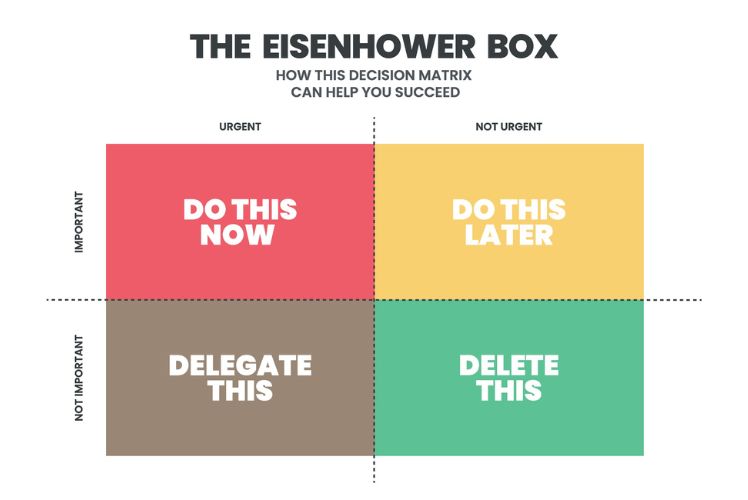Putting first things first is about focusing our energy on what matters most, rather than what simply demands our attention. Steve Covey’s third habit teaches us how to prioritise our time and decisions so that we invest in our biggest values and goals. Many of us get caught up in urgent tasks, but this habit challenges us to look past distractions and put importance where it truly belongs.

When we learn to put first things first, we gain control over our lives and reduce stress. It’s not just about being busy, but about making deliberate choices every day to act on what is most meaningful. Covey’s approach encourages us to use our principles as a guide so we can manage both our work and relationships more effectively.
Key Takeaways
- Focusing on priorities helps us achieve more meaningful goals
- Understanding the difference between urgent and important tasks is crucial
- Applying this habit improves our daily lives and relationships
Understanding Put First Things First

"Put First Things First" is about organising our time so we can focus on what matters most. By managing our tasks according to our values and goals, we become more effective in both our personal and professional lives.
Defining Habit 3 in The 7 Habits of Highly Effective People
Habit 3, "Put First Things First", is the practical step that follows deciding what we want in life. In Stephen Covey's "The 7 Habits of Highly Effective People", this habit means acting on our priorities every day, not just thinking about them.
This habit is not only about time management; it's about self-management. We need to distinguish between what is important and what is just urgent. Important activities contribute to our values and long-term goals, while urgent tasks often pull our attention but may not matter as much.
Key Points:
- Focus on key priorities, not just daily demands.
- Balance immediate tasks with long-term goals.
- Take control of choices instead of simply reacting.
By practising Habit 3, we become proactive in managing our actions, helping us reach our potential and improving our personal effectiveness.
The Role of Priorities in Personal and Professional Effectiveness
Prioritising helps us decide where to spend our energy and time. If we work without clear priorities, we often get trapped managing urgent but less important tasks, such as answering constant emails or handling other people’s crises.
Covey encourages us to use a system for setting priorities. One such tool is the Time Management Matrix, which divides tasks into four categories:
| Quadrant | Urgent | Important | Example |
|---|---|---|---|
| I | Yes | Yes | Crises, deadlines |
| II | No | Yes | Planning, relationship-building |
| III | Yes | No | Interruptions, some emails |
| IV | No | No | Time wasters, trivial tasks |
We should spend most of our time in Quadrant II. Tasks here help us grow and avoid future crises. By doing this, we become more successful and less stressed.
Stephen Covey's Principle-Centred Approach
Stephen Covey’s method for Habit 3 is grounded in living by core principles and values. He teaches us to let our true beliefs shape how we plan and act, rather than just reacting to what feels urgent at the moment.
When we choose principle-centred living, we base decisions on what really matters: integrity, honesty, fairness, and respect. This keeps us steady even when there is pressure to act on less important things.
Covey believes that acting from strong principles leads to lasting results and trust—both with ourselves and others. This approach brings order to our lives and supports true personal growth.
The Time Management Matrix and Four Quadrants

The time management matrix, developed by Stephen Covey, helps us organise tasks by urgency and importance. By sorting our work into four specific quadrants, we can reduce stress and focus on what truly matters.
Urgent and Important: Quadrant 1
Quadrant 1 contains tasks that are both urgent and important. These are often crises, pressing problems, and deadlines that require immediate attention. Examples include last-minute project work, immediate family emergencies, or unresolved conflicts at work.
We all have tasks in this quadrant, but spending too much time here can lead to constant stress and burnout. To manage these critical activities, we should act quickly, set clear priorities, and avoid letting small issues become full-blown crises.
Common Quadrant 1 tasks:
- Medical emergencies
- Unplanned meetings
- Deadline-driven projects
It’s essential to handle these tasks efficiently, but not let all of our time get spent here.
Strategic Planning in Quadrant 2
Quadrant 2 is where we find important tasks that are not urgent. This is the area of strategic planning, relationship building, and personal growth. Activities here might include setting goals, developing skills, exercising, or planning upcoming projects.
When we invest time in Quadrant 2, we prevent problems before they occur. We avoid many urgent crises because we have prepared in advance. Scheduling regular planning sessions, learning new skills, and maintaining our health are all examples of effective use of this quadrant.
Key benefits of Quadrant 2:
- Improved long-term results
- Less stress from last-minute surprises
- Stronger relationships
We should aim to spend more time here to achieve balance and success.
Managing Distractions: Quadrant 3 and Quadrant 4
Quadrant 3 includes tasks that feel urgent but are not important. These distractions often come from other people, like unnecessary phone calls, emails, or meetings. We may believe these need our attention right away, but they do not contribute to our long-term goals.
Quadrant 4 contains tasks that are neither urgent nor important. Examples are excessive television, social media scrolling, or activities that waste time without offering any value.
Here is a quick overview:
| Quadrant | Urgent? | Important? | Example Activity |
|---|---|---|---|
| Quadrant 3 | Yes | No | Interruptions, calls |
| Quadrant 4 | No | No | Idle web browsing |
To manage our time well, we must recognise these distractions and limit them. Focusing less on Quadrants 3 and 4 gives us more freedom to work on tasks that matter.
Applying Put First Things First in Daily Life

When we put first things first, we take control of our time and focus our energy on tasks that genuinely matter. Prioritising important activities, planning effectively, and managing our boundaries leads to strong personal effectiveness and steady progress towards our long-term goals.
Aligning Actions with Core Values and Long-Term Goals
To use Habit 3 well, we need to identify our core values and set meaningful long-term goals. This means we have to ask ourselves what truly matters and what we want to achieve in life. Writing down our key values and desired outcomes makes it easier to spot what is important.
We should regularly check if our daily actions represent these values and goals. Are we spending time on what we believe in, or getting lost in busywork? By comparing our schedule to our highest priorities, we can stay motivated and direct our energy where it counts.
A simple table can help us connect our actions to our values and goals:
| Value/Goal | Key Activity Last Week | Priority Level |
|---|---|---|
| Family | Dinner with family | High |
| Health | Morning walks | High |
| Career Progression | Completed training module | Medium |
| Creativity | Painted for 30 minutes | Low |
Regular reflection keeps us on track and improves our personal development.
Weekly Planning and Prioritisation Techniques
We can plan our week by blocking time for our most important tasks first. Using a weekly planner, digital calendar, or a notebook helps keep priorities clear. We start by adding fixed commitments, then schedule time for personal development, health, and long-term projects.
To prioritise effectively, we sort tasks into urgent, important, or not important using tools like Covey’s Time Management Matrix. We put our attention on activities that are important but not urgent—these often relate to our personal growth and future goals.
Short daily reviews can help us adjust our plans. When unexpected tasks crop up, we should ask: does this align with our top priorities? This approach makes our days intentional, not just reactive.
Learning to Say No and Delegation for Personal Effectiveness
Saying no is a crucial skill for protecting time and focus. If a task does not serve our key priorities or values, it’s better to decline politely rather than risk overload. This gives us the ability to choose what we spend our energy on.
Delegation is also a core part of personal effectiveness. By handing off tasks that others can do, we free up more space for activities that play to our strengths and support our main goals. We should communicate clearly when delegating, sharing what’s needed and by when.
Making these practices part of our routine ensures we work smarter, not just harder, and that our time goes towards what truly matters most in both work and personal life.
Put First Things First for Leadership and Relationships

When we focus on putting first things first, we manage our time and energy around what truly matters. Prioritising important activities helps us develop stronger connections, communicate more openly, and work better with others.
Building Trust and Collaboration
Trust forms the core of every strong team. When we make important relationships our priority, we show others that they matter to us. This creates a sense of security and respect.
By acting with integrity and following through on commitments, we help build mutual trust. Regular, honest conversations help set clear expectations. We become reliable partners who others want to work with.
Collaboration grows in this environment. People feel safe sharing their ideas. Everyone can focus on shared goals instead of individual concerns. This makes projects run smoother and leads to better results.
List of habits that encourage trust:
- Keeping promises
- Admitting mistakes openly
- Listening without judgement
Improving Communication for Mutual Benefit
Good communication helps everyone reach their goals. When we put first things first, we listen carefully instead of reacting quickly. We ask questions and try to understand before giving our opinion.
This focus on listening builds respect and makes it easier to solve problems together. When our teams share information clearly, it stops confusion and keeps everyone on the same page.
Mutual benefit comes from making sure both sides are understood and valued. By aiming for win-win outcomes, we create an environment where all voices matter.
| Communication Skill | Benefit |
|---|---|
| Active listening | Reduces misunderstandings |
| Asking clarifying questions | Builds clarity |
| Speaking honestly | Fosters trust |
Relationship-Building in Teams and Organisations
Strong teams rely on meaningful relationships. These are built through consistent, positive interactions and showing respect for each person’s contribution. We all play a role in creating a culture where people feel valued.
Recognising small achievements and celebrating progress together boosts morale. When we encourage openness and give space for feedback, it helps resolve conflicts sooner.
The maturity continuum is important here. As we move from dependence to independence and finally to interdependence, we become more effective together. This shift allows us to rely on each other’s strengths and build a collaborative environment that benefits everyone.
Put First Things First Within The Seven Habits Framework
Putting first things first requires us to actively choose what matters most and manage our time and energy around these priorities. We must connect our daily decisions to our values, goals, and overall personal growth.
Synergy Between Habits: Be Proactive, Begin with the End in Mind, and Sharpen the Saw
The habit of putting first things first relies on the foundation built by being proactive and beginning with the end in mind. Being proactive means we take responsibility for our actions and choices, rather than blaming circumstances. By starting with the end in mind, we create a clear sense of purpose and direction for what matters most.
Our ability to prioritise important tasks depends on our proactive mindset and our long-term vision. We become effective at managing our schedules, setting boundaries, and saying no to distractions. Integrating these habits also supports personal balance when we sharpen the saw—that is, taking time for self-renewal in areas like our health, relationships, and skills.
This connection between habits forms a strong mindset. With synergy, our actions support our deepest values and help us stay consistent over time.
The Maturity Continuum and Continuous Improvement
Put first things first is part of the maturity continuum, which describes our growth from dependence to independence and, eventually, to interdependence. By mastering this habit, we strengthen our capacity for emotional intelligence and self-discipline.
Continuous improvement, or "sharpening the saw," is essential. We need to set aside regular time for personal renewal—physical, mental, social, and spiritual. This ongoing process prevents burnout and ensures we can keep up with life’s demands.
As we actively review and adjust our habits, we encourage growth and development in all areas. We do not aim for perfection, but for steady, meaningful progress.
Frequently Asked Questions
We focus on applying Stephen Covey’s Habit 3: Put First Things First to everyday situations, clarify its distinct principles, and address some common misunderstandings. We examine its use for students, its difference from standard time management, and where to find further guidance.
What are some practical applications of the 'Put First Things First' habit in daily life?
We can use Habit 3 by prioritising our tasks based on importance, not just urgency. It helps us spend more time on activities that support our goals and values, like planning ahead or focusing on health. Simple examples include making a daily to-do list, setting aside study time before relaxing, or sticking to exercise routines.
How can students effectively implement the third habit, 'Put First Things First'?
Students can use this habit by planning their schoolwork before fun activities. Choosing study sessions before hanging out with friends or turning in homework ahead of deadlines are practical ways. Setting weekly goals or creating a timetable also ensures we focus on what matters most for our learning.
Can you summarise the key principles of Habit 3 from 'The Seven Habits of Highly Effective People'?
Habit 3 asks us to organise and manage our time around our personal priorities. We identify what is most important, create plans, and stick to them, even if other less vital tasks seem urgent. This means acting with purpose, using our willpower, and staying committed to our highest goals.
How does 'Put First Things First' differentiate from merely managing time?
Unlike standard time management, which often reacts to whatever is urgent, Habit 3 is about being proactive and making choices that reflect our values. We focus on activities with long-term benefits rather than short-term pressures. It teaches us to invest our energy into meaningful activities instead of just checking off tasks.
What are the typical misunderstandings about the 'Think Win-Win' approach?
A common mix-up is believing 'Think Win-Win' means everyone must always get exactly what they want or that there are no disagreements. In truth, it means seeking solutions where all sides feel satisfied and respected. We aim for fairness, not just compromise or giving in.
Where can I find a reliable summary of 'First Things First'?
A reliable summary can be found on trusted sites such as FranklinCovey’s official resources or educational blogs that review Covey’s books. These offer quick overviews and highlight practical steps related to Habit 3, making it easier for us to grasp and use the main concepts.

















